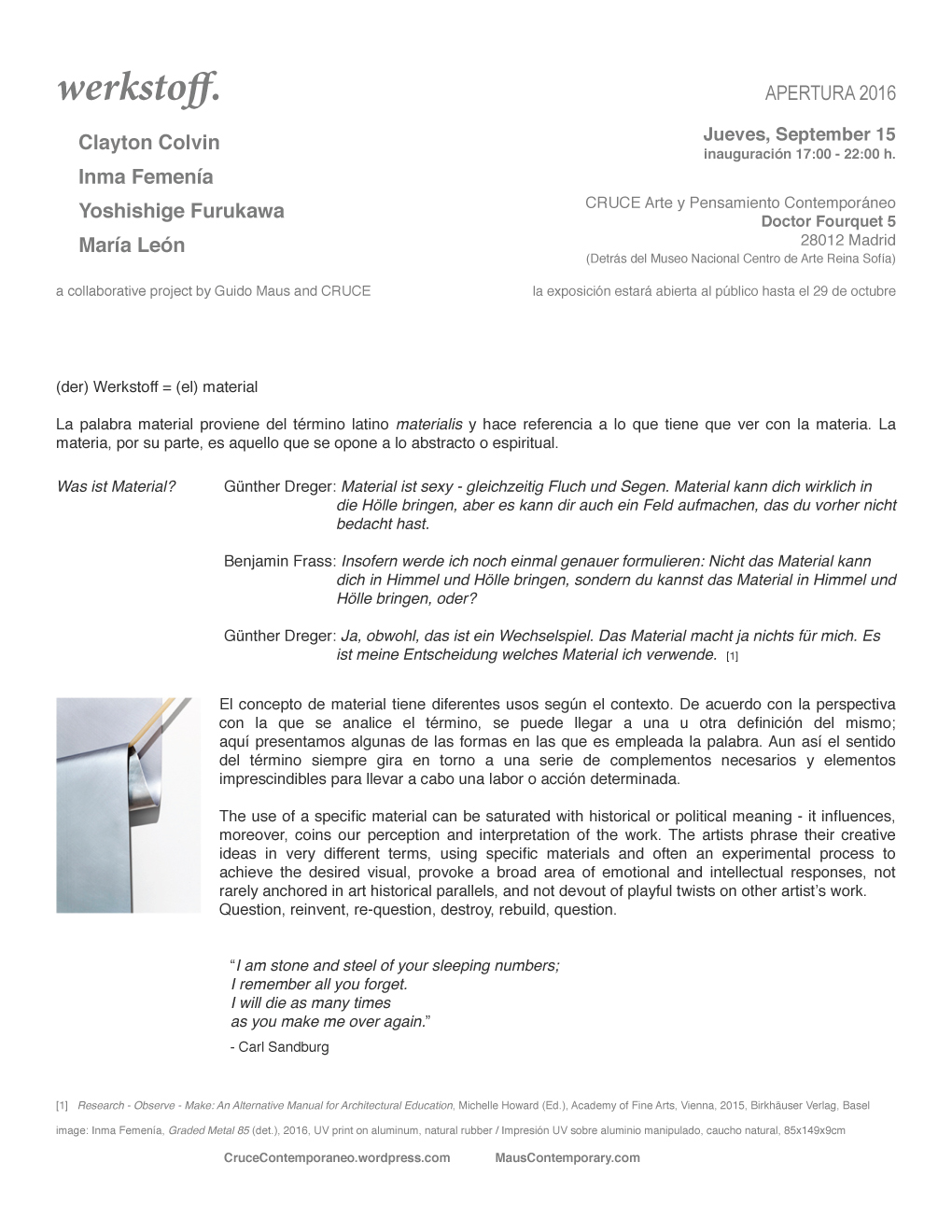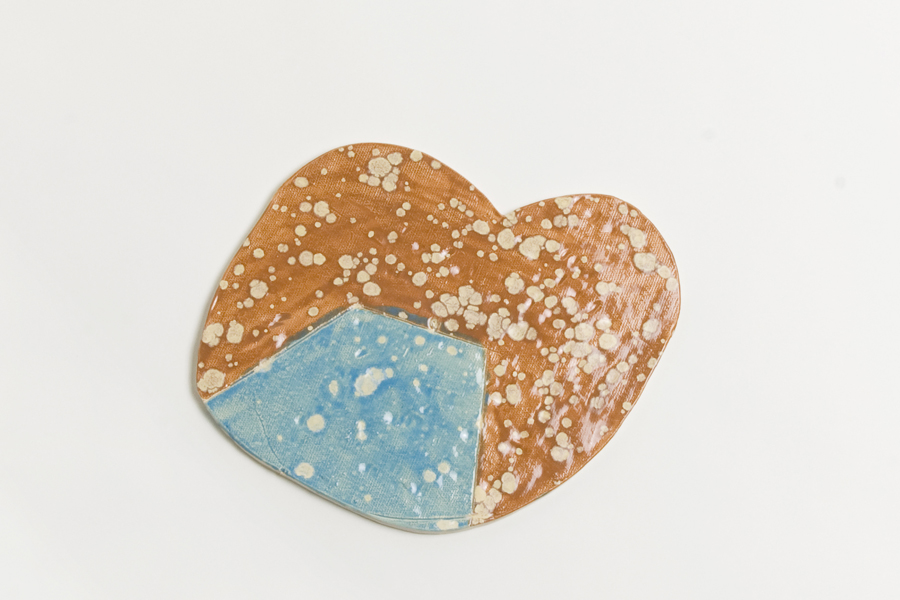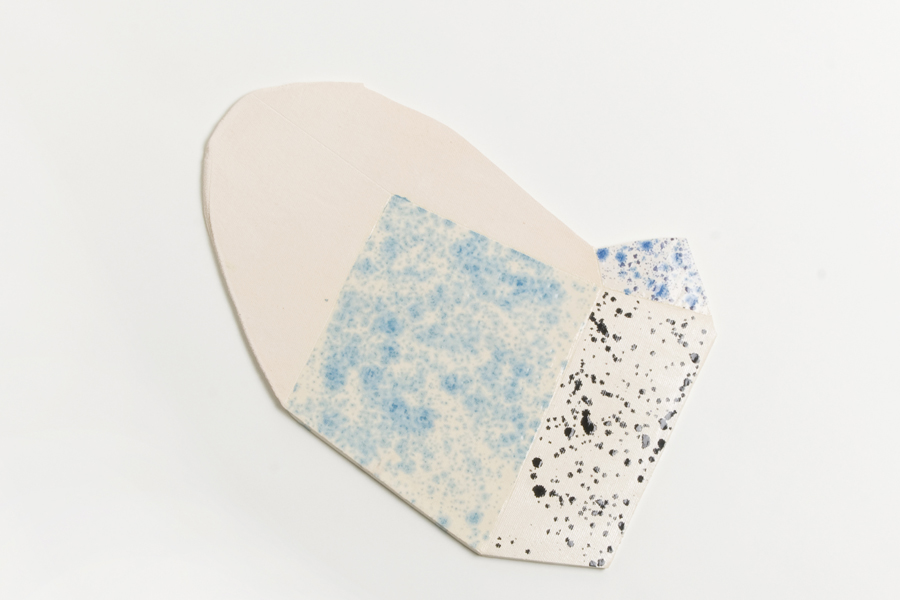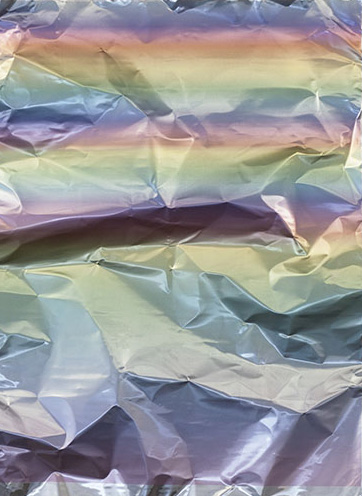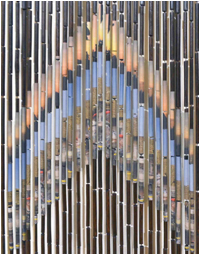Maus Contemporary
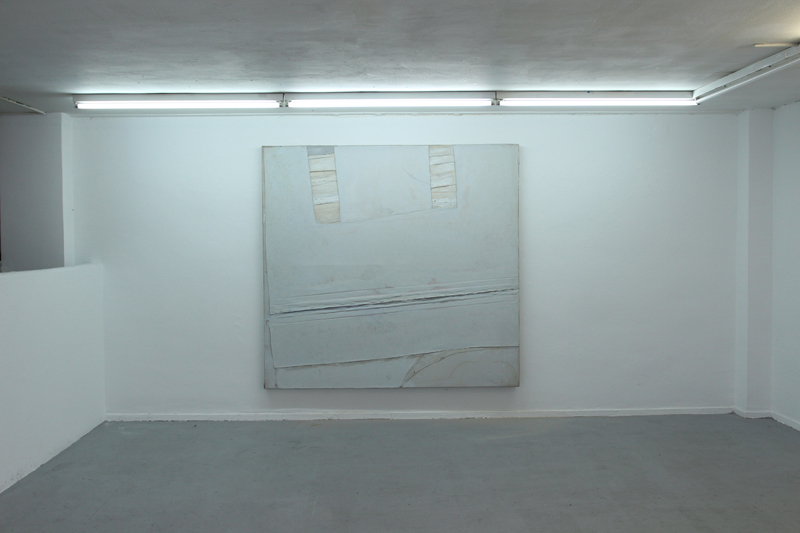
Clayton Colvin
Clayton Colvin has developed a practice of painting that is both challenging and seductive, using a hybrid of figurative and abstract approaches to create delicate, fantastic, and concrete spaces - the immediate and intimate nature of drawing infusing his paintings and ceramics with an hypnotic mix of familiarity and mystery. The artist’s work continues what critic Cinque Hicks described in Art in America as his “naked search for new answers to old questions.”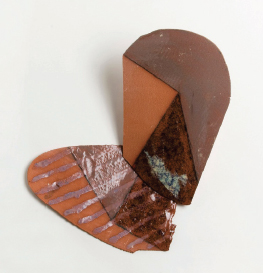 Clayton Colvin data bitesThe works included in this exhibition project are new ceramic objects, part of a body of work the artist playfully refers to as data bites, a practice started earlier this year to complete his extensive series of painting-based works.
Clayton Colvin data bitesThe works included in this exhibition project are new ceramic objects, part of a body of work the artist playfully refers to as data bites, a practice started earlier this year to complete his extensive series of painting-based works.
Colvin’s subtlety and dexterity comes from a decade-long interrogation of the practices and processes of drawing and painting. Having the capacity to represent the onslaught of technology against the resistance of history is an element of the Zen-like approach to Colvin’s studio practice.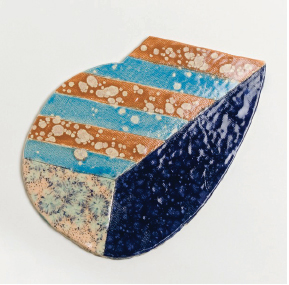 Clayton Colvin data bites
Clayton Colvin data bites
Rowan Ricardo Phillips, writing for Artforum, commented “ (...) At times, (Clayton Colvin’s) painting seems to give way to drawing, and at other times, drawing seems to give way to painting. Erasures and additions reveal and conceal other layers, complicating ideas of before and after, original and addition, right side up and upside down. The paintings thrive in paradox: They can seem crowded and full of movement, a sense of unsettled energy populating their spaces; after sustained viewing, however, a calm and measured contemplativeness saturates the canvases. (...) The paintings seem to move when you don’t look at them and stand still when you do - each striving to represent both the noise in which contemporary life finds itself ensnared, and the quiet meditation that can free it.”
Clayton Colvin (b. 1976) lives and works in Birmingham, Alabama. He received his BA in Art History from New York University in 1999 and his MFA in painting from the University of Alabama in 2005. Colvin’s work has been exhibited by galleries and museums across the US including the Birmingham Museum of Art (Birmingham, Alabama); the Mobile Museum of Art (Mobile, Alabama); and Artist Space (New York, NY).
Recent solo exhibitions include beta pictoris gallery (Birmingham, Alabama); Margaret Thatcher Projects (New York, NY); Launch F18 (New York, NY); the University of Montevallo (Montevallo, Alabama); and the University of Memphis Art Museum (Memphis, Tennessee). Colvin’s work is included in the permanent collections of the High Museum of Art (Atlanta, Georgia), the Birmingham Museum of Art (Birmingham, Alabama), and the Mobile Museum of Art (Mobile, Alabama). Reviews of his work have appeared in Art in America, Artforum.com, San Francisco Arts Quarterly, ArtPapers, etc.
Please contact PONCE+ROBLES to schedule viewing of an important selection of recent paintings and works on paper by Clayton Colvin.
Puede contactar con la galería PONCE+ROBLES para solicitar un visionado de una importante selección de obras originales en lienzo, tabla y papel del artista Clayton Colvin.
Inma Femenía
Nuestra manera de percibir el mundo está condicionada por el ámbito digital, entendido no sólo como vehículo de transmisión de imágenes, sino como un lenguaje cuya gramática modifica irremediablemente la apariencia de las formas. Bajo este punto de vista sitúo mi práctica artística, profundizando en el terreno digital, ahondando entre sus píxeles y vibraciones luminosas.
Recurro a dispositivos tecnológicos no tanto por sus tareas reproductoras de la realidad, sino porque me permiten mostrar las posibilidades plásticas de la huella digital y el carácter independiente del software.
Inma Femenía's (born 1985 in Pego, Alicante, lives and works in Valencia) work has been included in exhibitions internationally, most recently in the exhibition One Size Fits All at Ryder Projects, London; Espectros Visibles, Combustión Espontánea, Madrid; Bête Noire, Musart, Berlin; and her solo exhibitions include Graded Metal at Area 72, Valencia, Glitch at Zink Espacio Emergente, Sala Unamuno, Salamanca; El velo de Iris, Galería Kessler-Battaglia, Valencia; Àrea de llum 223m², Museo de Arte de Pego, Alicante; and Tensión, at the Centro Párraga, Murcia.
Her work is included in the collection of the Museo contemporáneo de Pego, Alicante; the Fundación Esprohident, Jerez de la Frontera, Cádiz; Colección DKV; Entidad Cultural Valenciana El Piló, Burjassot, Valencia; Galería San Vicente del Raspeig, Alicante; Universitat Politècnica de València, fondo de arte; Ministero dell’universita’e Di ricerca, Accademia di Belle Arti di Aquila, Italia; amidst others.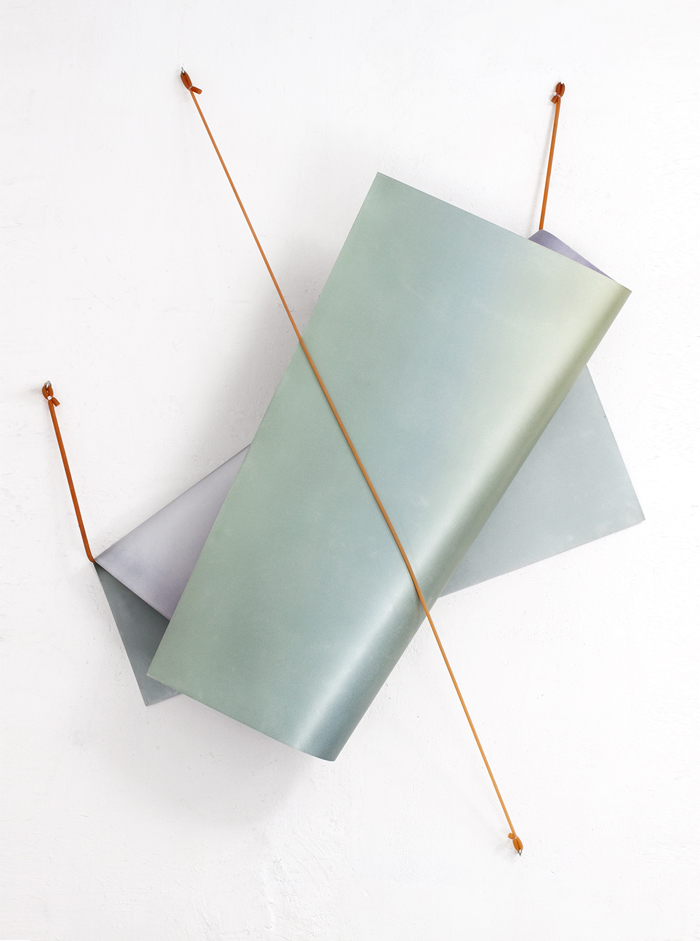 Inma Femenia Graded Metal 85
Inma Femenia Graded Metal 85
Inma Femenía
In Tension No 3
2016
UV print on aluminum, natural rubber
Impresión UV sobre aluminio manipulado y caucho natural
146 by 112 by 20 cm (57.5 by 44.1 by 7.9 in.)
Tras un recorrido que conjuga imagen fija y en movimiento, materiales rígidos, flexibles, opacos y translúcidos, soportes y fuentes electrónicos y mecánicos, Femenía ha abordado en los últimos meses las posibilidades de la superficie metálica, refractante, como receptáculo físico de sus señalamientos. De allí surge Graded Metal, en la que áreas específicas de la gama de colores degradados de softwares para tratamiento de imágenes son impresas digitalmente, sobre láminas de metal que luego son moldeadas de forma manual. El resultado es una serie de instantáneas cromáticas del cuerpo exterior, más bien la piel, del macroorganismo sistémico de la red. Una metáfora donde la combinación binaria de datos funciona como ente constitutivo, homologable a la unidad celular de la materia biológica.
Procurando transferencias entre la abstracción compositiva y las convenciones técnicas de la producción del color –entendida como despliegue cromático del haz luminoso-, en Graded Metal la autora combina con preciosismo el gesto sinuoso y la rigidez estructural. En un juego de pulsión entre la autonomía del material y el control de su conducta, perfila y depura correspondencias entre múltiple y único, fluido y estático, plano y volumétrico. Una estrategia que le permite recuperar también, cual desdoblamiento, espejismo o transmutación, la mineralidad inherente a los dispositivos de gestión de la información en la sociedad de redes.
El resultado es una secuencia de cuadros-escultura-objeto y una intervención específica en el espacio que funcionan como naturalezas muertas de la ‘mise en scène’ contemporánea. Paisajismos escultóricos a partir de los paisajes virtuales que infundan el imaginario post-Internet. Una apuesta por trascender, a través de la noción de masa, la cosmética electrográfica.
Un delicado equilibrio que es también un balance semiótico y formal. Hablamos de la suspensión serena, condensada, en medio de la velocidad y lo efímero del dato, de la violencia implícita en las transformaciones sociales provocadas por el carácter expansivo, casi esteroide, de la dualidad analógico-digital; aquella cuya progresiva imbricación en el imaginario instaura los cimientos de un renovado régimen de lo real, en un incipiente e impredecible s. XXI.
- Alex Brahim
Inma Femenía
RGB Spectrum
2014
UV print on aluminum
Impresión sobre aluminio manipulado
138 by 100 cm (54.3 by 39.4 in.)
Cuando el lenguaje digital se interpone y obtiene predominancia en nuestra percepción objetual, toma lugar una narración contemporánea visual. Este tipo de ajustes y estímulos visuales con los que estamos familiarizados nos aportan una fusión perceptual.
Como consecuencia surge el proyecto RGB Spectrum, el cual enfatiza el resultado natural del espectro cromático producido por la aplicación de calor sobre metal. En este proyecto se interpreta este proceso de forma digital, un espectro cromático creado por un software que traduce el fenómeno natural. La metodología procesual queda resaltada manipulando las variaciones del software, de este modo se consiguen las diferentes composiciones-abstracciones de color. La impresión se realiza sobre una superficie de metal en la que todavía no ha tenido lugar el proceso natural, sino que ha sido sustituido por el proceso digital.
RGB Spectrum define un espacio especifico que resalta el espectro cromático de la materia física, con una aproximación subordinada por la percepción digital. De esta unión de elementos surge una nueva mutación de los objetos con el presente, formando un conjunto perceptual en el que los limites quedan fusionados.
- Inma Femenía & Andrés Wittke
Yoshishige Furukawa (1921 - 2008)
“I am most interested in developing a visual space with color and forms on a visual plane. I start with the physical materials that a painter uses and then make changes based on intuition and on my reactions to the forms and colors present. When I am out walking, I may see a road, a construction site, working people, a tree, or the sky, and I try to incorporate the feeling of these visual physical things in my work. All of them have the power to cause me to ponder the relationship between the physical shape or material and mental reaction. Other influencing factors include the weather or conditions affected by time, body or even the sound of wind.”
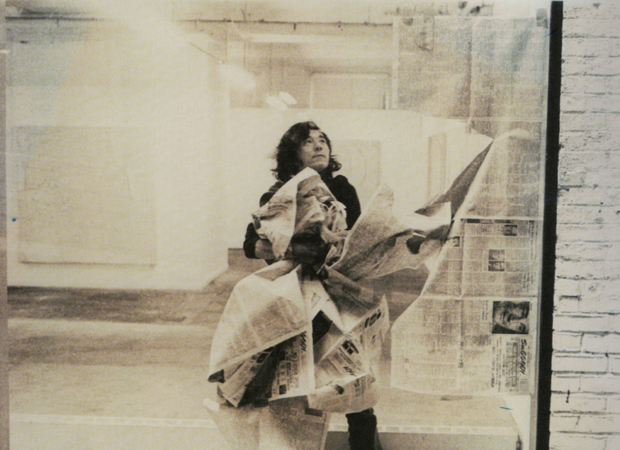 Yoshishige Furukawa in New York, 1972
Yoshishige Furukawa in New York, 1972
the artist in New York, 1972
Japanese artist Yoshishige Furukawa’s work shown in werkstoff. was created while living in New York, where the artist moved to from Japan in 1963. The work shows a shift in Furukawa’s practice - from a traditional, paint-based, to a process-based, minimalist approach, which ultimately culminated in the artist’s important and rare black-rubber-sheets series from 1975 and 1976 shown here. The non-color of black and the solid sense of the material of rubber reflected a rather reticent and ascetic impression of 1970’s art. Despite this, the various variations that were woven by the black geometric forms in triangles, squares and polygons continued to evoke dynamic senses of motion and expression that were alike in appearances but different in nature from the regularly repetitive element inherent to Minimalism.
Furukawa’s work was the subject of two major retrospectives at the Fukuoka Prefectural Museum of Art in 1992 and 2015, and is included n numerous important Japanese Museum collections, including the Tokyo National Museum of Modern Art; the Osaka National Museum of Art; the Kyoto National Museum of Modern Art; the Fukuoka Art Museum in Fukuoka; the Kitakyushu Museum of Art; the Saitama Museum of Modern Art; and the Saga Prefectural Art Museum; amidst others.
His work has been exhibited in the U. S. and Japan throughout his life, including the Albright-Knox Museum in Buffalo, NY in 1991. He’s the recipient of numerous important grants, twice from the Pollock-Krasner Foundation (1990 and 1997).
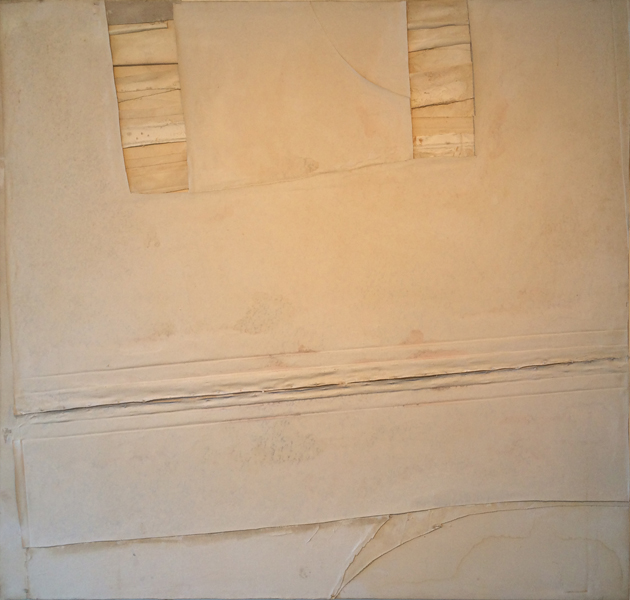 Yoshishige Furukawa Untitled, 1972
Yoshishige Furukawa Untitled, 1972
Yoshishige Furukawa
Untitled
1972
oil, gesso, and canvas collage on canvas
165 x 173,5 cm
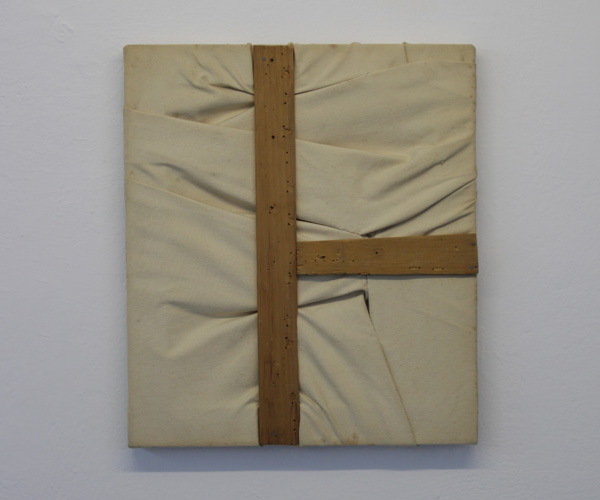
Yoshishige Furukawa
Untitled
1972
canvas, wood
41 x 36 cm
María León
María León (vive y trabaja en Berlín)
Licenciada en Bellas Artes y Diploma de Estudios Avanzados por la Universidad Complutense de Madrid. Ha participado en la última Bienal Internacional de Arte de Cerveira (Portugal). Entre otras galerías y centros de arte, su obra ha sido expuesta en la Embajada de España en Berlín (Back To The Future), en el Media Art Center de Moscú (Now&After Video Art Festival), en el Mykolas Zilinskas Art Museum de Lituania (Bienal de Kaunas Textil´11 Rewind-Play-Forward) y en el Military Museum de Belgrado (Top Secret Project). En la actualidad desarrolla su trabajo gracias a una beca de producción como artista residente en la fundación Bilbaoarte. Además, ha sido premiada en el XVI Certamen de Artes Plásticas El Brocense y recientemente seleccionada en la XVIII convocatoria internacional de la galería Luis Adelantado (Valencia).
Dirige junto a Alby Álamo el espacio de arte con sede en Berlín Urlaub Projects.
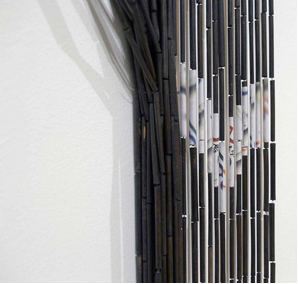 María León element II (det)
María León element II (det)
María León (born 1984 in Mérida, lives and works in Berlin) holds a degree in Fine Arts and Diploma of Advanced Studies from the Facultad de Bellas Artes de la Universidad Complutense de Madrid. Her work has been included in numerousions, such as Moves and *mods., Betakontext, Berlin; the Video Art Festival Now&After, Media Art Center Moscow, Russia; Back To The Future, Spanish Embassy, Berlin; the XVIII International Art Biennial of Cerveira, Portugal; and Bête Noire, Musart, in Berlin.
She is the recent recipient of the Bilbaoarte Art Project Residence Grant. María León and Alby Alamo run the project space Urlaub Projects in Berlin, Germany.
En emit ni tsol lost in time realizo el gesto de adornar una serie de cortinas creando formas ornamentales y en apariencia inofensivas.
Para intervenirlas utilizo imágenes de periódico repetidas extraídas de ejemplares de una misma tirada. Selecciono estas imágenes no sólo por sus características estéticas sino también por el contenido social, económico y político de las noticias que ilustran. Una vez creada esta paleta comienzo el proceso de decoración siguiendo un patrón determinado.
Como resultado, las cortinas se convierten en elementos portadores de apariencia visual pictórica que se cuestionan a sí mismas, siendo su propia carga simbólica -aquello que oculta y desvela al mismo tiempo- una reflexión en torno a los modos de ver actuales.
María León, emit ni tsol lost in time, curtains adorned with newspaper clippings, 90 x 200 cm each
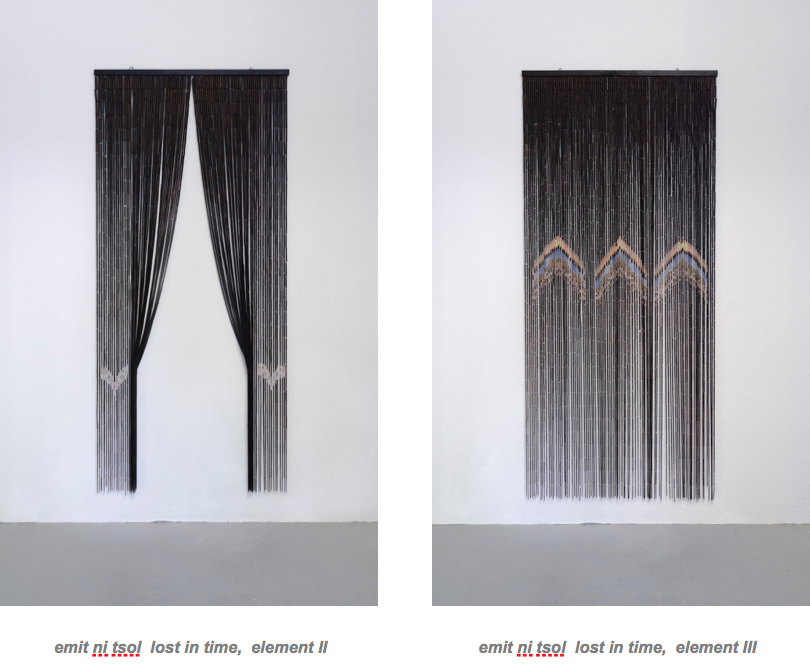 Maria Leon, emit ni tsol lost in time, element II, element III
Maria Leon, emit ni tsol lost in time, element II, element III
María León
emit ni tsol lost in time
element II element III
2014
door curtains, newspaper clippings
each 90 by 200 cm (35.4 by 78.75 in.)
emit ni tsol lost in time is a series of door-curtains, typical of many towns and villages of Southern Spain,, adorned with images extracted from various newspaper clippings. The cut-outs were selected not only according to their aesthetic value, but also due to their economical, social and political content. As a result, the ensuing decorative motives are viewed as beautiful and apparently inoffensive.
The curtains question themselves, as their symbolic meaning - that which simultaneously hides and shows - is a reflection of current ways of seeing.
